Combi boilers have no hot water storage and so they heat the water as it flows through the appliance. The appliances are categorised by their maximum power, measured in kW, and the maximum hot water flow rate:
| Morco Model | Max. Power | Maximum Hot Water Flow Rate | Temperature Lift |
| FEB20E | 24kW | 9.6 litres/minute | 35 °C* |
| FEB24 range | 24kW | 10 litres/minute | 34 °C* |
| EB24CPM | 24kW | 10.6 litres/minute | 35 °C* |
| GB24 range | 24kW | 9.9 litres/minute | 35 °C* |
| GB30 range | 30kW | 12.4 litres/minute | 35 °C* |
*Refer to section 3
All of the above combis have a water temperature control knob – this should be set to maximum unless the water being produced at a tap or shower is too hot in which case it should be turned down. If the water is too cool then one or more of the following is occurring:
1. The gas supply to the burner is too little
2. The water flow through the combi is too great
3. The mains supply water temperature is very low (this will only occur in winter)
4. Damaged mixer taps or shower mixer valve (usually caused by frost or high mains water pressure)
5. Low mains cold water operating/working pressure
6. One of the two combi heat sensors (thermistors) is faulty or is correctly indicating a problem
7. Damaged diaphragm (more prevalent in areas with chalky water)
8. A water saving shower head is fitted
9. Crossed pipework
10. More than one hot water outlet is being operated at once
The list looks a little long and our advice is to carry out as many of the checks supplied in the following notes yourself. It may lead you to the correct diagnosis without the cost of calling an engineer. In any event it will make you more confident when discussing the problem and solution with the engineer. Morco will connect any Gas Safe registered engineer with our technical team should they ring in during normal business hours. We will advise engineers how to diagnose the problem.
1. Gas supply
Insufficient gas reaching the combi will result in poor hot water delivery. Do not be fooled into thinking all is well just because the hob and/or the gas fire work – they use very little gas compared to the boiler and they can continue to operate even though some of the problems below are present:
- Gas regulator is damaged or of the wrong size – a minimum of 3.5kg per hour is recommended. This should be stamped onto the regulator situated on top of the bottle
- Gas type – Propane is recommended as it will continue to work even at the low temperatures we experience in the UK
- Bottle size – a 47kg propane bottle is required to reliably operate a combi in all conditions
The combis feature a gas valve that controls the amount of gas that is burned. If this is faulty then a Gas Safe registered engineer will need to be contacted.
2. Water flow through the combi is too great
All combi boilers (except the FEB20E) have water flow regulators fitted inside their cold water inlets. These ensure that the flow rate cannot exceed a certain level and hence the power of the boiler is sufficient to heat the quantity of water passing through it. If this regulator is damaged or missing then the quantity of water passing through the combi will be too great for it to provide hot water of an acceptable temperature.
Flow Restrictor – this is fitted inside the combi on the cold water inlet. It cannot usually be seen unless the cold water inlet system is removed from the inside of the combi. This is usually a job for an experienced engineer. The MCB2240 is about the diameter of a penny and is easy to lose or forget when re-assembling a boiler and this may explain why they can be missing.
|
|
|
| ICB124001 – GB models | MCB2240 – FEB24 models |
Solution
To test that the flow rate is correct you should open the hot tap in the kitchen fully and measure the amount of water that flows through it in 1 minute – if this exceeds the amount quoted for the model of boiler in the table on the first page then either:
- The flow regulator is likely to be damaged or missing
- There is a source of cold water that is diluting the hot water supply – see section 4 below
Please note: Some taps may have their own flow regulators fitted so this method may not be accurate
3. Supply water temperature low
The temperature lift quoted in the table on the first page is the amount of heat that the combi boiler gives to the water passing through it. If the water coming into the home from the mains water supply is 15°C and the temperature lift is 35°C then the temperature of water leaving the boiler will be the temperature lift of 15 + 35 = 50°C. This is more than warm enough for a shower and in fact the shower mixer will dilute this with cold to achieve a comfortable temperature. If the water entering the home is 3°C then the temperature of water leaving the boiler will be 3 + 35 = 38°C which is just hot enough for a shower but probably too cool for washing dishes. This issue applies to all makes and types of instantaneous water heaters such as combi boilers.
Solution
If the temperature provided by the combi is insufficient (maybe you prefer the washing up water to be hotter) then the only way of increasing the temperature is by slowing the flow through the combi by closing the hot water tap until the desired temperature is achieved. During winter months, when the water temperature entering the home is cold, use of this method may be vital to ensure acceptable hot water delivery.
4. Damaged mixer taps or shower mixer valve
Many Caravan Holiday Homes have mono-block basin taps and TMV2 shower mixer valves. These are very susceptible to frost damage even when the home has been drained down. This is due to the fitting of non-return valves in the shower mixer (see our factsheet on winterising your home). The damage caused by frost to these items is internal and so no leak shows. However, it causes cold water from the mains supply to enter the hot water supply once a hot outlet is open and this dilutes the hot water delivery. The boiler is functioning correctly but it cannot overcome damaged mixer taps or shower mixers.
Mixer taps and TMV2 shower mixers are generally specified to run at an incoming mains water pressure of 6 bar maximum. Operating them above this pressure either damages them or causes them to work incorrectly. Mains water pressure on parks varies throughout the year so it is possible for a TMV2 or mixer to work fine at certain times and then cause problems at others. Morco’s combination boilers and water heaters can tolerate a mains water pressure of 10 bar and so it will be the mixer/TMV2 that will cause problems first. Some manufacturers install pressure regulation valves on the incoming mains water and set them to 3 bar. Some parks with high or variable pressure also install the pressure regulators when siting a home.
This is a typical pressure reducing valve and it will be found close to the point at which the mains water supply enters the holiday home:

Diagnosis
An involved but failsafe way of checking the boiler is working correctly is as follows:
- Switch off the main water supply to the van at the stop cock
- Gain access to the van under the boiler and locate the hot feed pipe from the boiler. It is the left hand 15mm copper pipe as you look at the front of the boiler
- The copper pipe will either have a 15mm push fit tee or 15mm elbow connected (see below)


- Open a hot tap to relieve pressure
- Turn the wheel on the fitting that is closest to the copper pipe anti-clockwise until it stops
- Press the collet that is between the wheel and the copper pipe into the fitting as you pull on the fitting
- This should disconnect the fitting from the pipe
- Now place a bucket under the pipe and switch the cold water supply onto the van
- Hot water should now leave the copper pipe at a flow rate and temperature lift that matches the table on page 1
- If the flow rate is too high, the flow regulator in the boiler is likely to be missing ( section 2). If the flow rate is correct and the temperature lift is too low then you have established that the problem lies with the boiler, the gas supply or the water supply pressure
- The benefit of this procedure is that it operates the combi in hot water mode independent of the rest of the hot water pipework and outlets and so rules certain problems in or out
- Replacing the fitting is the reverse of removal
5. Low mains cold water operating/working pressure
All combi boilers have a minimum operating/working pressure (usually measured in bar) below which they will not function correctly. If the mains supply flow is too low this minimum operating pressure will not be achieved and will cause one or more of the following:
- The boiler not to fire when hot water is demanded
- With mixer taps and shower mixers hot water delivery will be poor
- One outlet will consistently provide hot water and yet another one will not
- Hot water delivery will come and go. For example, a shower temperature will rise and fall during the shower
- Water will run cold from a tap when a toilet is flushed or a cold tap is switched on and will return to hot when the toilet cistern is filled or the cold outlet is switched off
Solution
You will need to prove to the park that they are not providing you with sufficient water pressure. This can only be done by asking an engineer to place a pressure gauge in a tee on the cold water supply pipe below the boiler.
This is a photo of the underneath of a typical combi boiler before the gauge is fitted with the filling loop in place. The 15mm copper pipe 2nd from the right is the cold water inlet.

This shows a pressure gauge fitted to the cold water inlet pipe connected via the filling loop tee. Open the black plastic tap and the gauge will read the “standing pressure”. To read the “operating pressure”, open each hot outlet in turn and take a reading from the gauge while the hot water is running. This will provide you with the “operating pressure” for each hot outlet. The connection on the filling loop tee is ½ inch BSP. A good test to carry out is to flush the toilet, then open the hot tap at the sink and read the pressure. This is a very common scenario and the pressure needs to be high enough when it occurs.

If the operating/working pressure is less than 0.8 bar for the GB24/30 models or 0.3 bar for all other models, then the water operating/working pressure is too low to operate the appliance. DO NOT make the mistake of placing a pressure gauge on the end of the incoming water supply as this will provide you with “standing pressure” and this is not relevant in this instance. A high “standing pressure” DOES NOT ensure an acceptable “operating pressure”. Both standing and operating pressure can vary during the day depending on demand. It is not unusual for a boiler to work correctly at midday when hot water demand is low and not work at 7pm when demand for hot water on the park is high.
6. Boiler heat sensor (Thermistor)
This sensor tells the boiler controls at what temperature the hot water is being produced. The information supplied by the sensor is used to control the temperature of the hot water. If the thermistor is faulty, it will either tell the controls nothing (the boiler will lock out and show a fault code on the indicator – see relevant boiler manual for fault codes guides) or it gives the boiler controls an incorrect temperature reading. The latter causes the boiler to reduce the temperature of hot water it produces (it may not even allow the boiler to fire up).
Solution
A Gas Safe engineer will be able to test the output of a thermistor using an electrical multi-meter and hence diagnose any problems. Replacing the sensor in some boilers is straightforward (clip on type) and does not involve opening the gas combustion or the water circuits. Other boilers have a wet pocket type and this involves partially draining the primary circuit. Thermistors ARE NOT on or off switches and hence cannot be assessed using a continuity test or “shorted out” to get the boiler working. They produce a resistance that is proportional to the temperature being tested and only a multi-meter capable of measuring resistance can be used to diagnose their correct operation.
|
Boiler Type |
Thermistor Codes | Clip on Type | Wet Pocket Type |
| FEB20E |
FCB1175 |
Yes | No |
| FEB24E |
FCB1080 |
No | Yes |
| FEB24ED |
FCB1080 |
No | Yes |
| FEB24ED3* |
MCB2245 |
Yes | No |
| GB24/30 & SII |
ICB309001/ICB128001 |
No | Yes |
|
GB24/30
SIII & IV |
ICB309001/ICB128003 |
Yes | Yes |

|

|
|
| MCB2245 - Clip on Thermistor | FCB1080 - Wet Pocket Thermistor |
The FEB24ED3* boiler uses two of the MCB2245 to calculate the hot water temperature. Both of these need to be working normally for the correct operation of the combi. The GB range of condensing boilers also use two thermistors with part codes ICB309001 and ICB128001. Both these are wet pocket types and will require partial draining of the primary circuit to replace. This differs slightly on the SIII & IV models where the ICB128001 is replaced by the ICB128003 which is a clip-on thermistor.
7. Damaged diaphragm (more prevalent in areas with chalky water)
This problem only occurs with boilers in the FEB24 range. The FEB20E and GB range of boilers do not have a diaphragm.
The diaphragm is an EPDM rubber disc that is positioned in the heart of the boiler. It is subject to heat and a number of damaging chemicals found in mains water, such as chlorine and dissolved salts and as such is viewed as a consumable item. If the diaphragm splits the boiler will not switch from central heating mode to hot water. Once the hot tap is open the boiler may ignite but only warm water reaches the taps or shower. Another way to tell if this is the problem is to feel the temperature of the central heating flow pipe under the boiler while the hot tap is open. If it feels hot you have probably got a diaphragm problem. The flow pipe for the FEB24 and GB range of boilers is on the far left as you look at the front of the boiler.
Solution
You will need to contact a Gas Safe registered engineer to either replace the diaphragm (MCB2255) or the hydraulic valve kit (MCB2257, this houses the diaphragm). A good engineer can achieve this in approx. 1 hour.

|
MCB2255 – Diaphragm for the following boilers: FEB24 FEB24ED FEB24ED3* |

|
MCB2257 – Hydraulic Valve Kit FEB24 FEB24ED FEB24ED3* |
8. A water saving shower head is fitted
All combination boilers are designed to work with a certain working or operating pressure (see section 5) and a certain minimum flow rate of water passing through the boiler. Both of these parameters are influenced by the pipework and outlets on the hot water system. Certain shower heads, especially those advertised for water saving, can cause the boiler to either not fire or to fire with a low gas burn rate reducing the temperature of the water supplied. These shower heads only usually create the problem when the mains water pressure is relatively low. You may find that the hot water tap in the kitchen works fine but the shower does not. As water pressure on caravan sites can vary throughout the day, the problem may be intermittent.
Solution
To assess the situation, simply remove the shower head from the flexible hose and turn on the shower. If the water coming out of the pipe becomes hot then:
- The shower head needs replacing for a “full flow” type and/or
- The water pressure on the site needs increasing
Obviously the first solution is the easiest to carry out!
9. Crossed pipes
It is not unheard of for a caravan to be supplied with hot and cold pipes connected the wrong way around to a pair of taps or a shower mixer valve. This mistake can also be caused when repair work is carried out on the van, especially as a common repair is to replace the shower mixer tap due to frost damage. The effect is the same as a damaged mixer tap/shower mixer and the diagnosis and solution are highlighted in section 4 of the article. We have also come across homes where the manufacturer has crossed the hot and cold supply pipes under the boiler. The GB range of boilers will run in reverse but hot water delivery is affected and damage can occur. They also may make a weird noise!
10. More than one hot water outlet is being operated at once
Combination boilers in both the domestic and leisure market work in an identical manner and produce a set flow of hot water with a set temperature lift. In the case of Morco’s 24kW combis they supply approximately 10 litres per minute of hot water with a temperature lift of 35°C. This is fine for a shower when it is used by itself but when a hot tap or a second shower is opened at the same time the hot water delivery will reduce for both outlets.
If two outlets are opened at once you would think the 10 litres per minute of hot water would divide equally providing 5 litres per minute to each outlet. This is not the case as the pipe runs to each outlet will be of different lengths and provide different resistance to water flow.
Download a copy of this help article.



